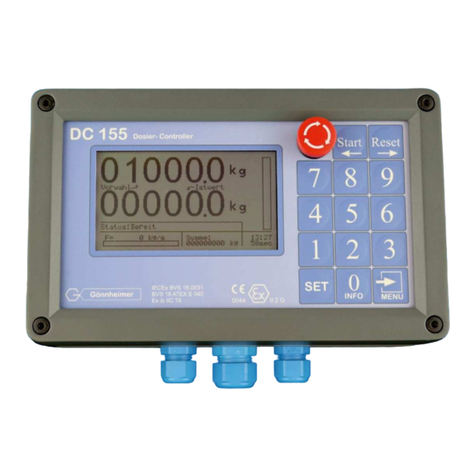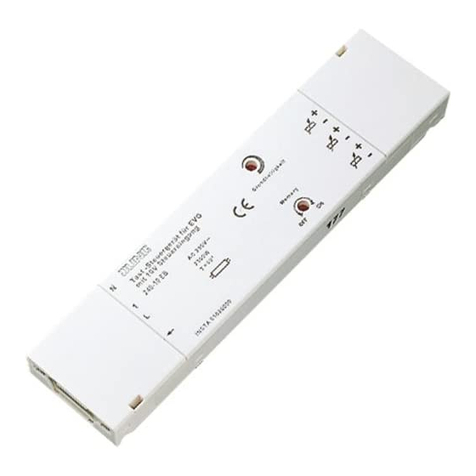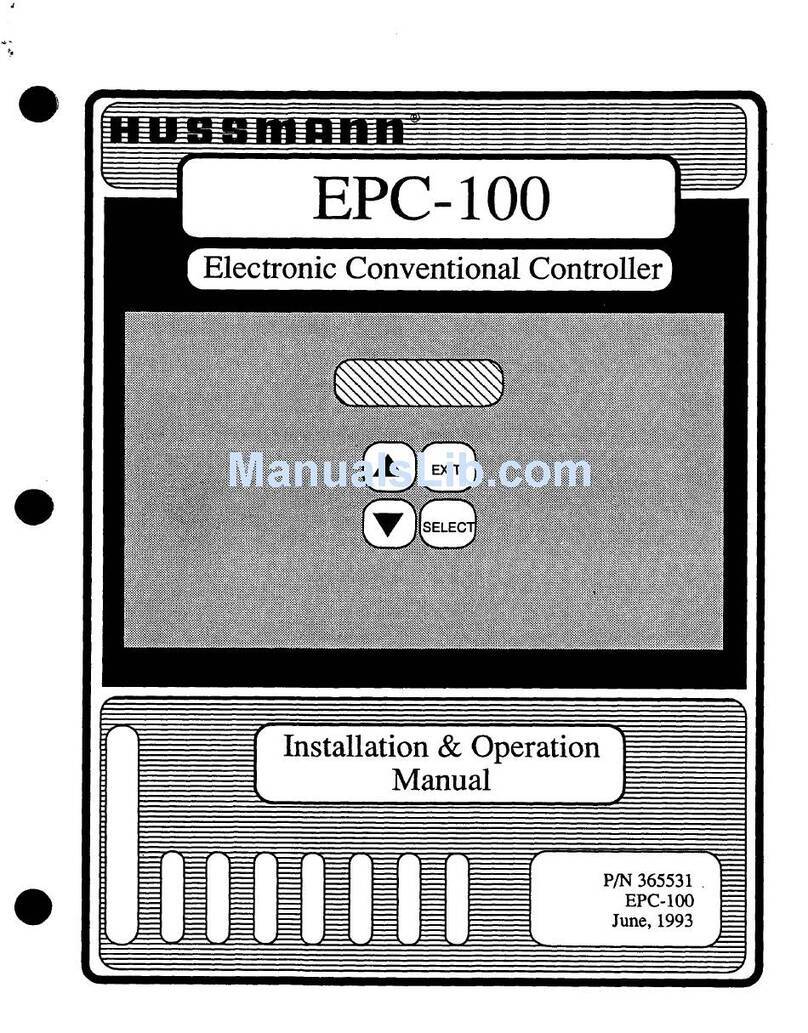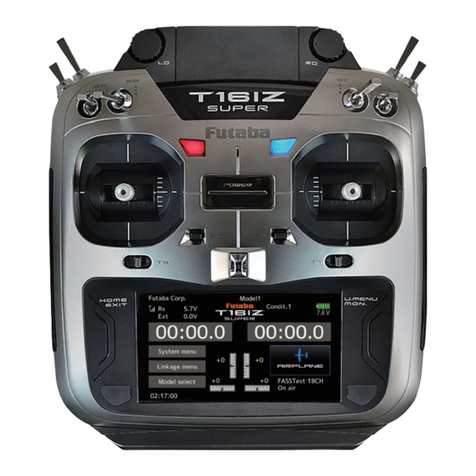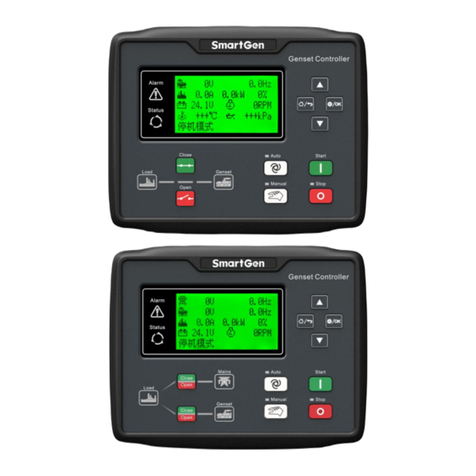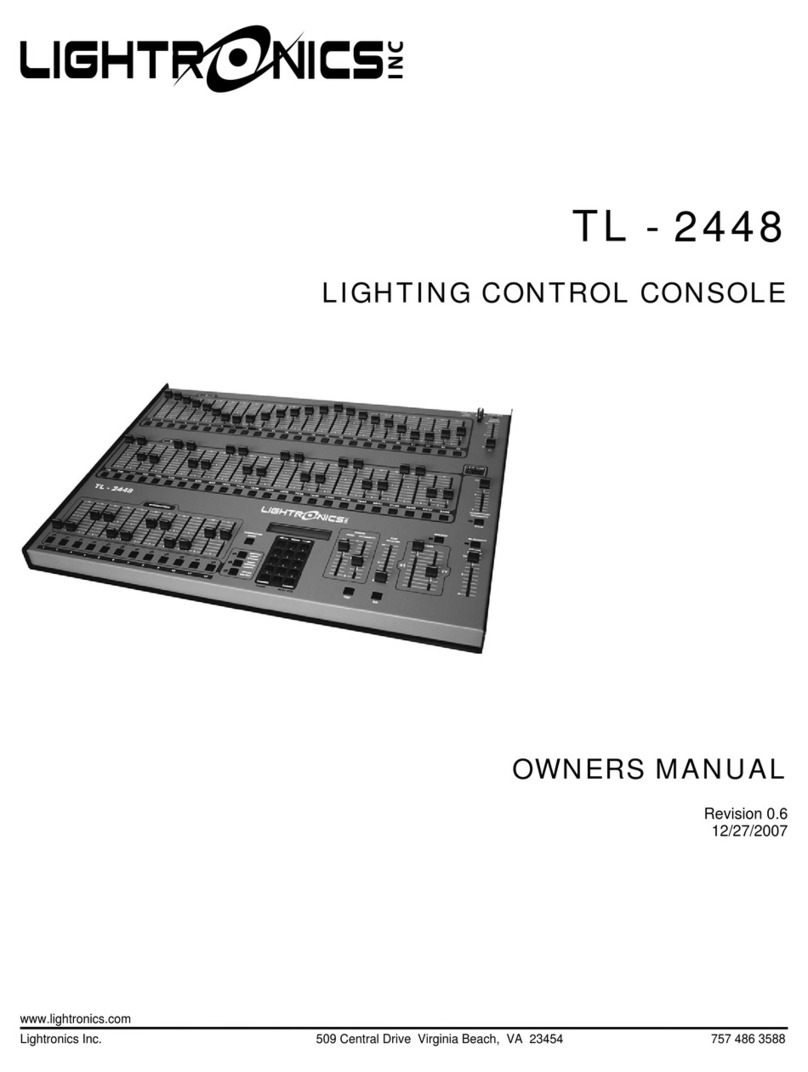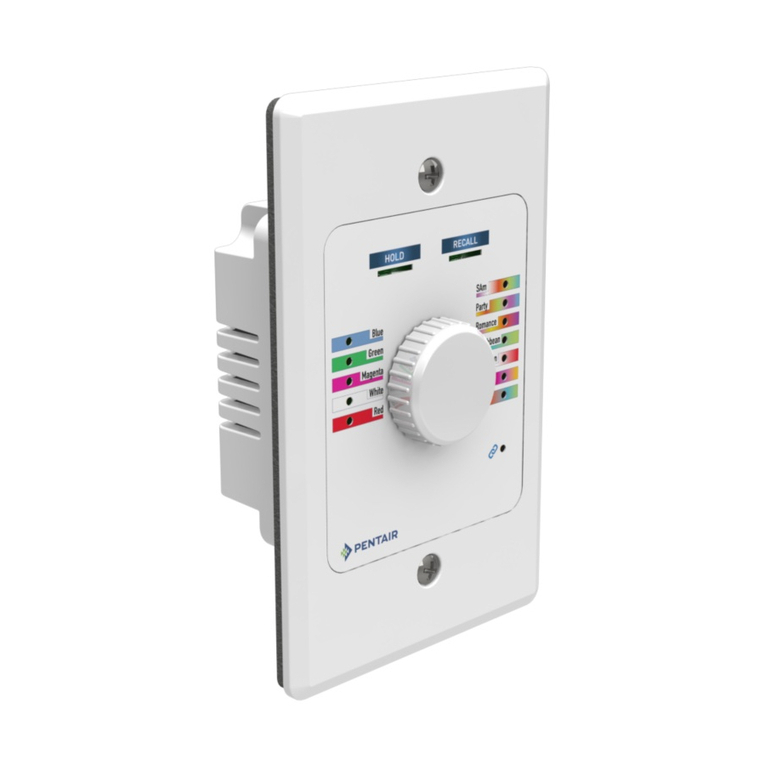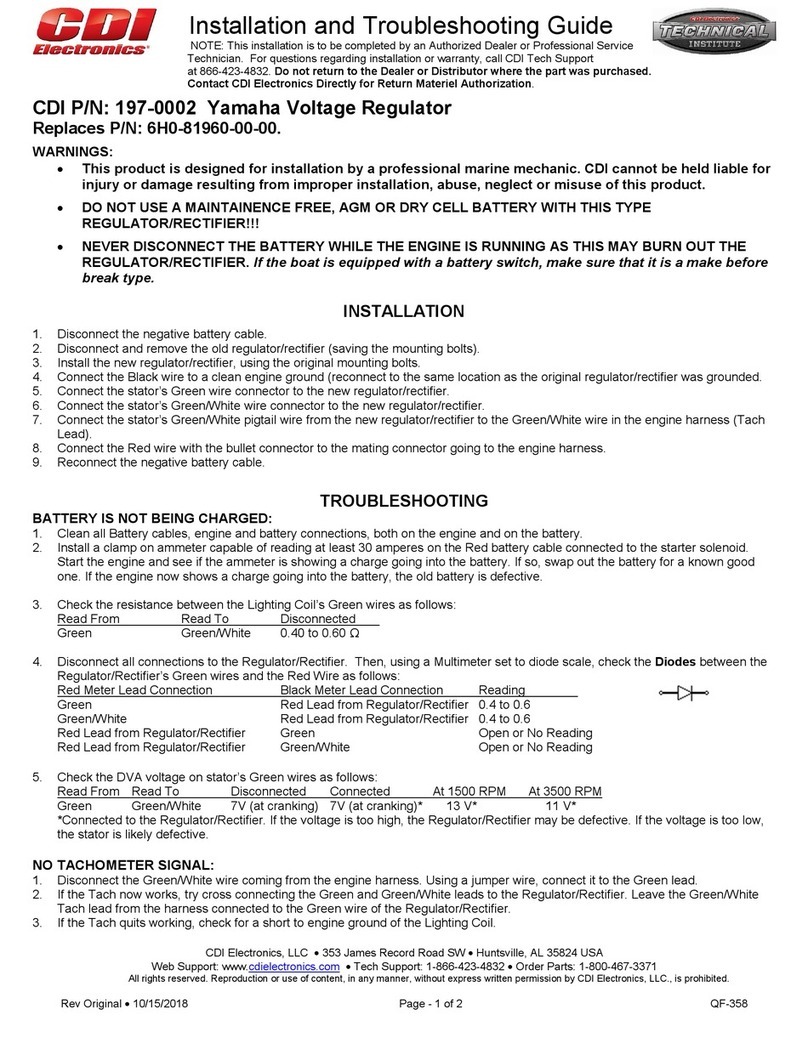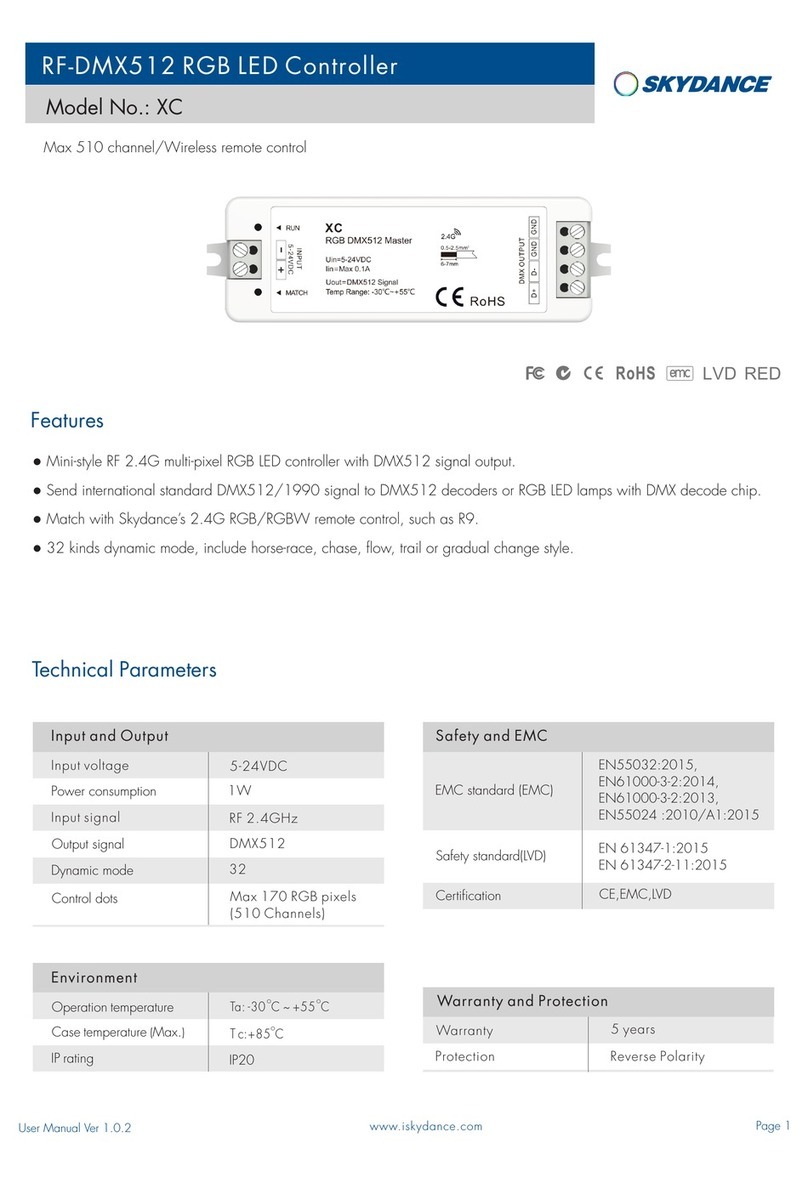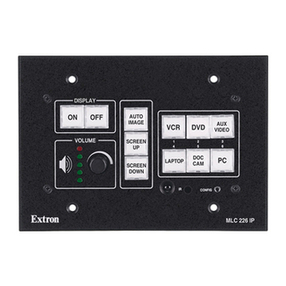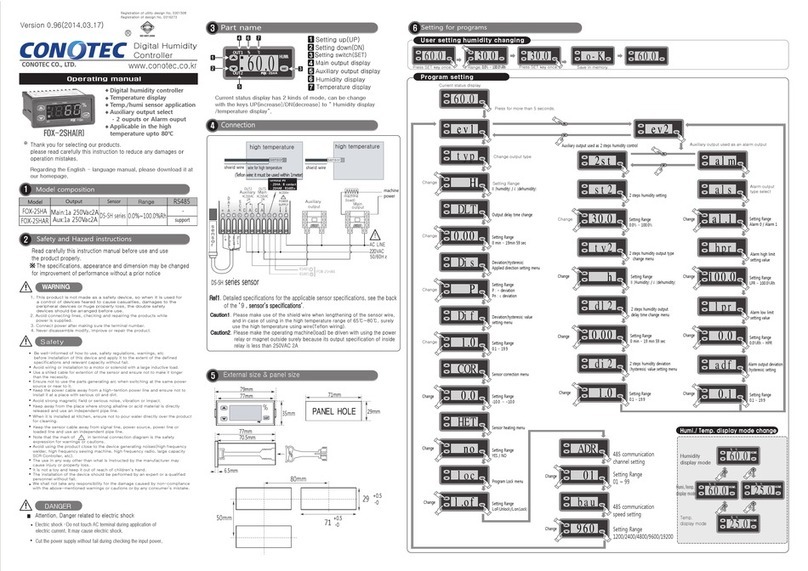Gonnheimer Elektronic DC 155 User manual

User's manual
Dosing- Controller
DC 155
Manual DC155_v2.0.16.doc

Page 2 1 safety guidelines DC155
Gönnheimer Elektronic GmbH phone.: +49 (6321) 49919-0, fax: -41 Email: info@goennheimer.de
Table of Contents
1OPERATION INSTRUCTION FOR EXPLOSION PROTECTED CONTROL PANELS................................... 3
2INTRODUCTION: DOSING - CONTROLLER DC155 ...........................................................................................4
2.1 Short description .......................................................................................................................................................... 4
2.2 Basics ........................................................................................................................................................................... 5
2.2.1 Units for preset, sum counter and flow ........................................................................................................................................5
2.2.2 Impulse value, analogous input scaling........................................................................................................................................5
2.3 Dosing applications...................................................................................................................................................... 5
2.3.1 Dosing control using digital solenoid valves................................................................................................................................5
2.3.2 Dosing control with proportional (analogous) valve....................................................................................................................7
2.3.3 Simultaneously Flow and batch control (Option) ........................................................................................................................9
2.3.4 Batch control with absolute level signal (requires 4.. 20mA analogous input option )................................................................9
2.3.5 Forward - backward Impulse counter (requires 2 Impulse inputs option)...................................................................................9
2.4 Creep suppression ........................................................................................................................................................ 9
2.5 Temperature compensation (requires Pt100- option) ............................................................................................... 10
2.6 Process monitoring..................................................................................................................................................... 10
2.6.1 Broken wire monitoring.............................................................................................................................................................10
2.6.2 Flow monitoring.........................................................................................................................................................................11
2.7 Safety.......................................................................................................................................................................... 11
2.7.1 Code words ................................................................................................................................................................................12
2.7.2 Key locking................................................................................................................................................................................12
2.8 Remote control / bus coupling.................................................................................................................................... 12
2.8.1 Remote control via digital inputs...............................................................................................................................................12
2.8.2 TTY- interface and protocol print (Option) ...............................................................................................................................12
2.8.3 Modbus (Option)........................................................................................................................................................................13
2.9 Calibrated version, batch result print out ................................................................................................................... 14
2.9.1 Supply and interface module VI156.X.1.X................................................................................................................................14
2.9.2 Calibrated sensor, setting for redundant sensor wire..................................................................................................................14
2.9.3 Actor(s)......................................................................................................................................................................................14
2.9.4 Central printer for several batch control stations .......................................................................................................................14
2.9.5 Additional Settings on DC155 ...................................................................................................................................................15
2.10 Scale signal amplifier connection............................................................................................................................... 16
2.10.1 Connection WV157....................................................................................................................................................................16
2.10.2 Scale menu / manual settings.....................................................................................................................................................16
2.10.3 Scale calibration.........................................................................................................................................................................17
3INSTALLATION AND CONNECTION................................................................................................................... 18
3.1 Mounting.................................................................................................................................................................... 18
3.2 Wiring ........................................................................................................................................................................ 18
3.2.1 Terminal description DC155......................................................................................................................................................19
3.2.2 Power supply..............................................................................................................................................................................19
3.2.3 Sensor terminals.........................................................................................................................................................................20
3.2.4 Actor terminals...........................................................................................................................................................................21
3.2.5 TTY- interface ...........................................................................................................................................................................21
3.3 Power supply of DC155............................................................................................................................................. 22
3.3.1 Application inside hazardous area..............................................................................................................................................22
3.3.2 DC155 for safe area application.................................................................................................................................................22
3.4 Starting, parameter default settings............................................................................................................................ 22
3.5 Reset........................................................................................................................................................................... 23
4OPERATION MANUAL.............................................................................................................................................23
4.1 LC-Display................................................................................................................................................................. 23
4.2 Keyboard.................................................................................................................................................................... 24
4.3 Parameter input and Configuration ............................................................................................................................ 25
4.3.1 Input assistance: blinking menu items........................................................................................................................................25
4.4 Dosing control flow chart........................................................................................................................................... 25
5ANNEX .........................................................................................................................................................................27
5.1 Block diagram DC155................................................................................................................................................ 27
5.2 Technical Details........................................................................................................................................................ 28
5.3 Type code................................................................................................................................................................... 28
5.4 (Ex- safety) terminal maximum ratings...................................................................................................................... 29
5.5 Documentation table................................................................................................................................................... 30

DC155 1 safety guidelines Page 3
Gönnheimer Elektronic GmbH phone.: +49 (6321) 49919-0, fax: -41 Email: info@goennheimer.de
!
1Operation instruction for Explosion protected control panels
Application and Standards
This instruction manual applies to explosion protected control panels of type of
protection types below. This apparatus is only to be used as defined and meets re-
quirements of EN 60 079 particularly EN60 079-14 "electrical apparatus for poten-
tiality explosive atmospheres". It can be used in hazardous locations which are
hazardous due to gases and vapours according to the explosion group and tempera-
ture class as stipulated on the type label. When installing and operating the explosion protected distribution
and control panels the respective nationally valid regulations and requirements are to be observed.
General Instructions
The control panel has to have a back-up fuse as stipulated. The mains connection must have a sufficient
short circuit current to ensure safe breaking of the fuse. To achieve an impeccable and safety device opera-
tion, please take care for adept transportation, storage and mounting, as well as accurate service and main-
tenance. Operation of this device should only be implemented by authorised persons and in strict accor-
dance with local safety standards. The electrical data on the type label and if applicable, the "special con-
ditions" of the test certificate PTB 98 ATEX 2071 are to be observed.
For outdoor installation it is recommended to protect the explosion protected distribution and control panel
against direct climatic influence, e.g. with a protective roof. The maximum ambient temperature is 40°C, if
not stipulated otherwise.
Intrinsically Safe Circuits
Erection instructions in the testing certificates of intrinsically safe apparatus are to be observed. The elec-
trical safety values stipulated on the type label must not be exceeded in the intrinsically safe circuit. When
interconnecting intrinsically safe circuits it is to be tested, whether a voltage and/or current addition occurs.
The intrinsic safety of interconnected circuits is to be ensured. (EN 60079-14, section 12)
,Safety Measures: to read and to comply
Work on electrical installations and apparatus in operation is generally forbidden in hazardous locations,
with the exception of intrinsically safe circuits. In special cases work can be done on non-intrinsically safe
circuits, on the condition that during the duration of such work no explosive atmosphere exists. Only ex-
plosion protected certified measuring instruments may be used to ensure that the apparatus is voltage-free.
Grounding and short circuiting may only be carried out, if there is no explosion hazard at the grounding or
short circuit connection.
,Safety aspects
A batch control system built exclusively with the DC155 represents a control system in category 1 accord-
ing EN954-1. If a higher safety is required, it is necessary to install independent working safety facilities.

Page 4 2 Introduction DC155 DC155
Gönnheimer Elektronic GmbH phone.: +49 (6321) 49919-0, fax: -41 Email: info@goennheimer.de
2Introduction: Dosing - controllerDC155
The following chapter 2 shows the whole functionality of the DC155, sorted by subject. Important hints for
mounting, installation and starting are introduced in chapter 3. A short intro for structuring and parameter
input of the DC155, as well as the complete functionality of the front keys and the display can be found in
chapter 4.
2.1 Short description
The dosing controller DC155 is an all purpose dosing control device to manage batch controlling of any ar-
bitrary liquids or solid products inside the hazardous area. Advantages of this device are:
•simply handling, an orderly key pad containing big (22 x 22 mm) keys,
•a large graphic display and a
•flexible wide functionality.
The DC155 can manage simple as well as complex dosing applications inside hazardous area, without a
extensive wiring to a DCS. See advantages below:
Several Input sources It is possible to connect any common transmitter: NAMUR or 24V digital in-
puts are the standard input terminals, 4 up to 20 mA input as an option.
γ-factor
Temperature
compensation
The additional Pt100- input terminal allows a temperature compensation, if the
space expansion factor γof the dosing product is known and not neglectible.
Intelligent dosing fea-
tures The intelligent dosing program of the DC155 prevents shocks on the pipe
system using a continuos raise and fall ramp by the 4 up to 20 mA – propor-
tional valve output, as well as using a pair of fine and coarse valve.
Intelligent batch
monitoring Furthermore the DC155 includes a trouble alarm system to report flow distur-
bances or sensor failures. Obviously, the flow monitoring can be delayed to
prevent wrong alarm during the start and finish period of the batch.
Simply remote con-
trol The DC155 has several digital control inputs to realise a simple remote control
with the basic functions like “START, STOP and RESET”.
Powerful analogous
output The analogous output can manage a load of 600 Ωdirectly. The optional sepa-
rate supply extend the load up to 1000 Ω.
PID-controlled Dos-
ing process Some applications need a regulation of the flow during the batch process. The
option “regulated analogous output” can manage this applications with an in-
ternal PID- controller.
Data safety The data is stored on an onboard EEPROM, if the power supply fails. The
DC155 continues at the restored state, when the mains is back.

DC155 2 Dosing controller DC155 Page 5
Gönnheimer Elektronic GmbH phone.: +49 (6321) 49919-0, fax: -41 Email: info@goennheimer.de
2.2 Basics
2.2.1 Units for preset, sum counter and flow
The first step to configure the DC155 is to define the physical unit for preset, sum counter and flow. There-
fore sufficient unit symbols are implemented into the DC155 (e.g. gram (g), kilogram (kg), tons (t), liter (l)
etc.) To define the flow several time units are available.
2.2.2 Impulse value, analogous input scaling
The DC155 get its information about the present flow via impulse or an analogous signal from a flow sen-
sor. If it is a impulse signal, you have to define the value of one impulse to get the right amount of flow.
If the sensor signal is an analogous signal, you have to define the maximum flow (e.g. 1000 kg/min) for 20
mA.
The Impulse value and analogous input scaling is located in the structure menu in the input category.
2.3 Dosing applications
Generally, a batch control system content a flow measuring, one or two valves and the batch controller.
The flow sensor measures the quantity of the product per time, which flows into the target bowl and sends
this information to the batch controller. The controller receive the flow information, integrates the flow
signal to a sum, compares the sum continuously with the preset and controls the connected actors, which
themselves controls the flow into the target bowl.
The DC155 supports many sensor signals: 24V active/passive, NAMUR, 4 ..20 mA (analogous current
signal) and several actors. The following application examples are sorted by the kind of actors:
2.3.1 Dosing control using digital solenoid valves
The most common dosing application is the batch control using a coarse and fine valve. When the batch
process is starting both valves open – a big flow of the product starts to flow. Before the preset is reached
(at preset minus preset 2) the coarse valve shuts and the remain quantity will be added very exactly.
Additional it is possible to configure a opening delay of the coarse valve (preset 1) and a lag quantity to
take care of the pipe system and to get the exact desired quantity. See the following time diagram to under-
stand the function of these.

Page 6 2 Introduction DC155 DC155
Gönnheimer Elektronic GmbH phone.: +49 (6321) 49919-0, fax: -41 Email: info@goennheimer.de
Beside it is possible to define a maximum preset, to allow only equal or smaller presets to be set.
The DC155 has three free programmable digital outputs. In the example above two of them must be re-
served for valve control. The following figure shows any possible function of a digital output.
Select the function of digital output
1:
0. No function
1. Counter = 0
2. Fine valve
3. Wide valve
4. Dosing is running
5. Any failure
6. Flow too small
7. Flow too big
8. Impulses
. End
Figure 1 Digital output functions

DC155 2 Dosing controller DC155 Page 7
Gönnheimer Elektronic GmbH phone.: +49 (6321) 49919-0, fax: -41 Email: info@goennheimer.de
Function Description (definition: output in normal open connection)
1. Counter = 0 The digital output is closed, if the actual value is equal to zero. Otherwise the digital
is the digital output open.
2. Fine valve control output for a valve with a fine cross section in normal closed connection.
Also the control output for a single valve.
3. Wide valve control output for a valve with a wide cross section in normal closed connection
4. Dosing is running The output is closed, as long the preset valve is not reached and the pause time is
not expired. Otherwise the digital is the output open. See also the time diagram
above.
5. Any failure The output is closed, as long any disturbance (broken wire, flow to big, etc) is oc-
curring to the DC155 or failure is no more present, but not acknowledged. Other-
wise the digital is the digital output open.
6. Flow to small The output is closed, as long the flow rate is too small or this failure is not acknowl-
edged. Otherwise the digital is the digital output open.
7. Flow too big The output is closed, as long the flow rate is too big or this failure is not acknowl-
edged. Otherwise the digital is the digital output open.
8. Impulses Flow proportional signal: the output gives one pulse for any increase of the actual
value.
Table 1:function list of digital output
The total quantity of various batch processes is stored by an additional sum counter. The sum counter is
shown permanently at the bottom of the display. Obviously, the sum counter gets no reset after each batch.
So, it provides information about the dosed product for several batches or over a longer period of time.
Furthermore it is possible to realise a very simple batch control using only one digital solenoid valve. In
this case you have to configure the single valve as a fine valve. Consider, the parameters like preset 1 and
preset 2 (but not lag quantity !) lose their functions.
2.3.2 Dosing control with proportional (analogous) valve
The DC155 can content a 4 ..20 mA analogous output to control a proportional solenoid valve as an op-
tion. The batch control parameters as shown above have by this actor version the same function. Consider
the following diagram for details.
You can configure the analogous output to a 0 ..20 mA or to a 4 ..20 mA signal. To get the functionality as
shown in the diagram just configure the analogous output to “ Ramp shape”.
It is possible to adjust the shape of the ramp. The parameter category shows at the menu item 'analogous
output' the parameter 'Limit for analogous output' for limiting the maximum shape of the ramp as well as
the ‘start value of the rising ramp’ and the 'End value of the falling ramp' to adjust the end value of the
falling shape to 0% up to 100 %.

Page 8 2 Introduction DC155 DC155
Gönnheimer Elektronic GmbH phone.: +49 (6321) 49919-0, fax: -41 Email: info@goennheimer.de
Preset1
Stop Start
Lag quantity
time
100 %
Actual value
Preset
0 %
On
Off
Proportional-
valve
Start
Preset 2
Preset
Report:
batch process
is running
Pause time
expired
Start value
of the rising ramp End value
of the falling ramp
You can configure the analogous output to a 0 ..20 mA or to a 4 ..20 mA signal. To get the functionality as
shown in the diagram just configure the analogous output to “ Ramp shape”.
Any alternative functions for the analogous output are shown below:
Select the function of the analogous out-
put:
0. No function
1. Flow prop. signal
2. Ramp shape
3. Flow feedback control
4. Counter p. sig.
5. Counter (max) p. sig.
. End
Figure 2 Functions of the analogous output

DC155 2 Dosing controller DC155 Page 9
Gönnheimer Elektronic GmbH phone.: +49 (6321) 49919-0, fax: -41 Email: info@goennheimer.de
Function Description (definition: output in normal open connection)
1. Flow prop. signal The analogous output is proportional to the actual flow 0/3 mA = 0 l/s; 20 mA =
max. flow. Define max flow in the input menu
2. Ramp shape The analogous output deals with a proportional working solenoid valve. See work-
ing diagram above
3. Flow feedback control The analogous output deals with a proportional working solenoid valve and flow
rate control
4. Flow prop. Signal The analogous output shows the actual batch amount (0/4 mA = 0%; 20 mA =
100%)
5. Counter (max) p. sig. The analogous output shows the actual batch amount (0/4 mA = 0%; 20 mA = max.
setpoint)
2.3.3 Simultaneously Flow and batch control (Option)
The DC155 has an internal PID- flow controller as an option. See item 3 of figure 2 above. With this option
the DC155 is a batch controller and a PID- flow controller in one device. The batch controller fills up the
desired volume and the flow controller regulates the medium flow to the predefined setpoint flow during
the batch process. The setpoint flow has also a ramp shape as shown above. The dynamical behaviour of
the feedback flow controller can be adjusted with the common PID parameter set Kp, Ki and Kd located in
the parameter category.
Like the uncontrolled output, the preset 1 and preset 2 defines a ramp shape of the analogous output to limit
the slew rate. Set maximum output, if required, in item "Analogous output" in the parameter menu.
2.3.4 Batch control with absolute level signal (requires 4.. 20mA analogous input option )
This kind of batch control works not with a flow signal, but with an absolute level signal. The dosing proc-
ess remains the same.
2.3.5 Forward - backward Impulse counter (requires 2 Impulse inputs option)
Some kinds of flow sensors (e. g. windmill-type anemometer) recognises back flows. These have two sen-
sors. The DC155 can determinate the flow direction using the phase relation of the two sensors.
Configuration and handling of the DC155 with this option is equal to any standard application.
2.4 Creep suppression
In some cases, it is necessary to ignore a
transductor signal bigger than 4 mA. This
threshold level is called creep suppression
value. The figure on the right hand shows
its function.
Adjust the creep suppression value in the
structure category.
measurement valu
e
creepsupressionvalue
Term o
f
the sum
Figure 3: creep suppression

Page 10 2 Introduction DC155 DC155
Gönnheimer Elektronic GmbH phone.: +49 (6321) 49919-0, fax: -41 Email: info@goennheimer.de
2.5 Temperature compensation (requires Pt100- option)
Any fluid has a specific expansion coefficient γ, i.e. in general, the volume of the fluid increases with its
temperature. So using a volume measurement sensor for a mass dosing application, introduces an inaccu-
racy into the dosing process, if the temperature changes. This inaccuracy is not neglectible for big γ.
In this cases utilise the temperature compensation of the DC155, to compensate the expansion coefficient
of the fluid. The DC155 corrects the density of the medium according the following formula:
)](1[ R
ϑ
ϑ
γ
ρ
ρ
−
−
=
with
ρ: density,
γ: expansion coefficient,
ϑ: actual Medium temperature
ϑR: reference temperature
For this the DC155 measures the temperature of the fluid via the Pt100 input. Further requirement are the
expansion coefficient of the fluid and the reference temperature. See the category below:
Settings for temperature compensation
0. Temperature compensation: active
1. Reference temperature: 20°C
2. Coeff. of expansion:: 0.00 E-3 1/K
. End
2.6 Process monitoring
A batch process can be interrupted by several disturbances and errors. Even if a dosing error is inevitable, it
is preferable that in any case an alarm indicates the cause. Please consider beside the following monitoring
features description the batch process flow chart in chapter 4.4.
2.6.1 Broken wire monitoring
The analogous 4 ..20 mA signal as well as the NAMUR- signal have according to their specification a
„LIVE-ZERO“- attribute, i.e. the signal quality "zero" is dissimilar to its physical zero quality. So, it is
possible to a recognise rip off or a destruction of sensor wiring.
If a sensor wire brakes, then the DC155 interrupts the batch process and indicates "Broken wire" on the
display. It is possible to report the "Broken wire" disturbance via a any digital output.
Acknowledge the disturbance status by pressing the RESET- key. A second push on the RESET- key re-
sets the DC155 batch counter to zero. Alternative it is possible to continue the batch process by press-
ing the START- key.

DC155 2 Dosing controller DC155 Page 11
Gönnheimer Elektronic GmbH phone.: +49 (6321) 49919-0, fax: -41 Email: info@goennheimer.de
2.6.2 Flow monitoring
Flow fluctuations are considerable disturbances particularly if a reactor will be filled simultaneously with
several substances or the flow exceeds the flow sensor limits.
The DC155 can monitor min and max flow limits. If flow exceeds limits, the DC155 interrupts the batch
process after a programmed time delay and indicates the disturbance on the display. It is possible to report
the disturbance via any digital output.
The figure 4 shows an example of a flow at start of a batch. The delay times are as follows:
ta, : General delay
tb: Selective delay at F > F max
tc: Selective delay at F < F min
t
Max
Min
Flow
F
F
tttt
a
b
b
c
The general delay starts on the begin of batch – the selective delays starts in that moment the flow exceeds
its limit. If the flow did not return when the delay time is over the corresponding alarm causes.
Acknowledge the disturbance status by pressing the RESET- key. A further push on the RESET- key re-
sets the DC155 batch counter to zero. Alternative it is possible to continue the batch process by press-
ing the START- key.
2.7 Safety
Thoughtlessness and carelessness of unauthorised people are often the cause of failures of total automatic
dosing systems. We took measures on the DC155 to prevent unintentional or incompetent interruptions to
the dosing process.

Page 12 2 Introduction DC155 DC155
Gönnheimer Elektronic GmbH phone.: +49 (6321) 49919-0, fax: -41 Email: info@goennheimer.de
2.7.1 Code words
The competence to enter or manipulate configuration or parameter settings are divided into 3 safety levels:
1. The lowest level is the competence to change the preset. The authorised persons, who know the code
word 'preset' are able to change the preset not more. The ex works preset code word is
'0001'. If this lowest safety level is not necessary, so disable the preset code word by setting it to
'0000'.
2. The medium safety level is the competence to enter the parameter category. In this category it is
possible to enter or to change all remaining batch parameter like preset 1, preset 2, lag quantity, pause
time, flow limits, limits delay, PID-controller parameter and the internal time clock as well as to reset
the sum counter. The ex works preset code word is '0002'. The parameter category pass word can not
be disabled by setting it to '0000'. The medium safety level is dedicated e.g. to maintenance personal.
3. The highest safety level is the competence to enter the structure category. In this category it is possible
to change the entire structure (configuration) of the DC155 (e.g. type of unities, input signal, output
signal, indication, temperature compensation, flow monitoring, key blocking) as well as changing code
words. The ex works preset code word is '0003'. The structure category pass word can not be dis-
abled by setting it to '0000'. The highest safety level is dedicated e.g. to the plant engineer.
2.7.2 Key locking
In some applications the DC155 works total automatically, e.g. on remote to a DCS, without any manual
control. In this cases, it will be practical to block the keys of the DC155 to prevent an unauthorised inter-
vention.
The DC155 has three level of key locking as follows:
1. Any key is enabled
2. Any key is locked, except the START,STOP and RESET keys
3. Any key is locked
After the configuration, the key locking is active, if the key lock signal input (terminal 15) is high.
2.8 Remote control / bus coupling
The DC155 has several interfaces to realise remote control.
2.8.1 Remote control via digital inputs
The DC155 has five predefined digital signal inputs (START, STOP, RESET, INHIBIT and KEY
LOCK) to realise a simple remote control with passive switches or to a high level control system (e.g.
DCS).
The threshold of the inputs is Low- Signal < 2 V and High- Signal > 5 V
Any signal inputs except the STOP input are fix predefined in normal open connection, the STOP input is
predefined in normal closed connection.
2.8.2 TTY- interface and protocol print (Option)
A quite more elegant kind of remote control is via a DCS and ESC -sequences. See the instruction codes in
the following table

DC155 2 Dosing controller DC155 Page 13
Gönnheimer Elektronic GmbH phone.: +49 (6321) 49919-0, fax: -41 Email: info@goennheimer.de
Instruction code Function
ESC 0 Request for counter (present value) state
ESC S START- instruction
ESC P STOP- instruction
ESC Z RESET- instruction
ESC K1 Enable keys
ESC K0 Lock keys
ESC B PRESET Set preset (e.g. PRESET = 001000 )
ACK (hex. 06) Answer to a known instruction
NAK (hex. 15) Answer to a unknown instruction
The DC155 answers with a complete batch protocol print (contents date, time, preset amount, real (fin-
ish) amount), if the protocol print is enabled (Menu/structure/TTY interface) and it gets the 'ESC Z' in-
struction.
2.8.3 Modbus (Option)
a) Registers
The modbus interface uses only "Holding Registers" to submit measurement values and commands. The
registers are defined as below:
Register
(Hex) Access Data format Function
40001
R/W
R/W
R/W
R
R
R
R
R
R
R
R
Bit field Ctrl-Flags:
Bit 0: Start Dosing process
Bit 1: Stop Dosing process
Bit 2: Reset Counter
Info-Flags:
Bit 8: Dosing process is started
Bit 9: Dosing process is stopped
Bit 10: Counter is equal to zero
Bit 11: Broken wire Sensor 1
Bit 12: Broken wire Sensor 2
Bit 13: minimum flow rate alarm
Bit 14: maximum flow rate alarm
Bit 15 Counter overflow
40002
40003 R/W Floating point Preset
40004
40005 R Floating point Actual value
40006
40007 R Floating point Flow rate
Remarks
•The „Read only“ marked Bits in Register 40001 are write protected i.e. ignore these bits while writing
in this register. Write using the function 16 „Preset Multiple Registers“ and write the registers 40002
and 40003 simultaneously, otherwise the DC155 would not recognise the new preset.

Page 14 2 Introduction DC155 DC155
Gönnheimer Elektronic GmbH phone.: +49 (6321) 49919-0, fax: -41 Email: info@goennheimer.de
•After writing a new preset into the registers 40002 and 40003, the DC155 will take the new preset at
the next dosing process (not to the running dosing process).
b) Functions
The DC155 supports the Modbus functions below:
Function number Function
3 Read Holding Registers
6 Preset Single Register
16 Preset Multiple Registers
a) Hardware
The DC155 uses Modbus RTU, 9600 Baud, supports TTY only. The parity can be set to even, odd or inac-
tive.
2.9 Calibrated version, batch result print out
The calibrated batch system contents:
1. Batch controller DC155.X.X.X.X.4.X.X
2. Supply and interface module VI156.X.1.X
3. Calibrated sensor
4. Actor
5. Calibrated printer, interface protocol according DIN 66258
2.9.1 Supply and interface module VI156.X.1.X
The Supply and interface module VI156.X.1.X is an Ex- interface module with 3 digital working inputs, 2
digital working outputs and serial interface. It works in hazardous area zone 1 with the DC155. Besides the
VI156 feeds the DC155 with Ex i- Energy.
2.9.2 Calibrated sensor, setting for redundant sensor wire
A calibrated batch process needs a calibrated sensor. If this sensor has terminals for 2 pulse outputs signals,
so connect both to the DC155. Please configure the redundant sensor input in the Input menu of the DC155
for accurate working.
The DC155 will show “Sensor failure !” if the wiring is not ok. After fixing the error quit the failure mes-
sage by pressing the “RESET” button on the front. A second press the “RESET” will restart the batch proc-
ess.
2.9.3 Actor(s)
The VI156 has 2 internal Ex i to Ex e- relay terminals. So user can connect Ex e- actors like motors, pumps
or valves direct in hazardous area.
2.9.4 Central printer for several batch control stations
Use a “Auto data switcher” in safe area to connect several batch controller to one printer.
Enter a individual header in each DC155 to separate the prints.

DC155 2 Dosing controller DC155 Page 15
Gönnheimer Elektronic GmbH phone.: +49 (6321) 49919-0, fax: -41 Email: info@goennheimer.de
2.9.5 Additional Settings on DC155
a) Menu blocking of the calibrated DC155
The menu of the DC155 must be protected against unauthorised manipulation especially by calibrated proc-
ess. For this reason there must be a cable bridge inside of the DC155 to enter the menu of the DC155.
To enter structure menu must
the correct code word be entered and
put a wire bridge between terminal 3 and 16
b) Print out
For a calibrated batch process the batch data must printed out. For this enable “Print protocol” iun the
Configuration of the DC155.
The print out shows:
[Infotext]
[Date] [Time] [Set-point] [Actual Value]
c) Info text
With the info text field you can set a individual text on the print out. The text length is 20 characters at
maximum. The text can be entered in menu “TTY- interface”, choosing “info text”. A list with all available
characters are shown. Select a character with the arrow buttons and put it into text with the enter button.
Delete wrong characters with “<” and confirm the info text with .
Input the infotext:
ABCDEFGHIJKLMNOPQRSTUVWXYZ0123456789.
>
Batch position 1

Page 16 2 Introduction DC155 DC155
Gönnheimer Elektronic GmbH phone.: +49 (6321) 49919-0, fax: -41 Email: info@goennheimer.de
2.10 Scale signal amplifier connection
The combination of the dosing controller DC155 and the scale signal amplifier WV157 is a dosing system
which works with a scale signal in hazardous area. The personnel starts the batch per „start“ key on the
DC155. The growing weight of the good is recognised by a scale (working with a strain gauge). When the
preselected weight is reached the DC155 stops the filling process automatically. The DC155 works with a
decreasing weight signal too.
The scale signal amplifier is used to transform the weight signal. The small difference signal of the strain
gauge will be amplified, transformed to digital and sent to the Dosing controller.
Correct mounting of the WV157 in hazardous area is close to the scale to reduce disturbances. The even
more disturbance safe digital output signal can be transmitted via a longer distance to the DC155 in haz-
ardous area.
For further information see manual WV157.
2.10.1 Connection WV157
Connect the WV157 to terminal 27 to 29
Figure 4 Connection of WV157
2.10.2 Scale menu / manual settings
The scale menu contents all settings of the load cell and the scale amplifier. A calibration procedure can
complete parameters, if some parameter are unknown.
Settings for dosing with balance
0. Weight rises while dosing
1. Measuring range
2. Zero cal.
3. Tare : Auto
4. Koeff. cal. : Ja
5. Max. load cell : 10kg
6. Gain of WV157: 1d/mV
7. Balance signal : 0.200mV/V
8. Balance signal is : positive
9. End
Function Description
0. Weight rises while dosing The weight will rise while batch procedure, alternative the weight can fall
while batch procedure
1. Measure range Sets the maximum span of the scale
2. Zero cal. Set the signal immediate to zero
3. Tare Automatic tare means that the scale signal is define to zero at the start mo-
ment

DC155 2 Dosing controller DC155 Page 17
Gönnheimer Elektronic GmbH phone.: +49 (6321) 49919-0, fax: -41 Email: info@goennheimer.de
4. Koeff. cal. Choose “Yes” If you have the parameters of the load cell shown below. If
not choose “No” and make a calibration
5. Max. load cell Maximum weight of the load cell
6. Gain of WV157 Adjustment of the gain of the load cell
7. Balance signal Output signal / sensibility of the load cell
8. Balance signal is Polarity of the output signal of the load cell
2.10.3 Scale calibration
Are the parameters of the scale and load cell unknown – choose “No” at “Koeff. Ca.” (item 4). The menu
will change immediately to the screen below.
To calibrate the scale system: load cell, scale signal amplifier WV157 and DC155 a calibrated weight is
needed. First make a zero calibration (item 2) with the unloaded scale. Then enter the amount of the weight
load the scale (item 5) and load the scale with the weight and choose item 6. The calibration is done.
Settings for dosing with balance
0. Weight rises while dosing
1. Measuring range
2. Zero cal.
3. Tare : Auto
4. Koeff. cal. : No
5. Calibration point : 10 kg
6. Load cal.
7. End

Page 18 3 Installation and connection DC155
Gönnheimer Elektronic GmbH phone.: +49 (6321) 49919-0, fax: -41 Email: info@goennheimer.de
3Installation and connection
3.1 Mounting
The DC155 is dedicated for mounting and working in hazardous area zone 1. Please use the 4 holes on the
rear plate for mounting and use a solid base.
,NB Observe local safety guidelines and the regulative
VDE DIN 57 165
See hole distances below:
Gehäusetiefe: 112 mm
M16x1,5
Sp 5-10 M16x1,5
Sp 5-10
M20x1,5
Sp 10-14
110
160
14
7
19
90
130
170
240
260
Figure 5: Dimensions
3.2 Wiring
,NB Please note the following Standard of Compliance: PTB 98
ATEX 2071 and the regulative VDE DIN 57 165
,Warning Do not exceed terminal safety limits of any terminal.
See terminal limits on table 5.4 in the annex or the standard of compliance PTB 98 ATEX
2071
Housing height: 112 mm

DC155 3 Installation and connecting Page 19
Gönnheimer Elektronic GmbH phone.: +49 (6321) 49919-0, fax: -41 Email: info@goennheimer.de
3.2.1 Terminal description DC155
Terminal Description
1,2 +
5,6 - Power supply input
3 + Power supply input/ Option: separate power supply for analogous ouput
4 + supply output for NAMUR- Sensors
7 - Connect only to a NAMUR sensor supplied on terminal 4
8 + Input for 24V impulses
9 - Connect only to a NAMUR sensor supplied on terminal 4
10 + Input for 24V impulses
11,12,13,14,15,16 Digital inputs (11-16: START, STOP, RESET, INHIBIT and key lock)
17+ 19+ 21+
18- 20- 22-
Digital output
23+
24- Analogous inputs
27, 28, 29 Digital interface to scale amplifier WV157
29+
30- Analogous output
31 +, 32 , 33
34- Terminal for PT100, 4 wire connection
35+
36- TTY- receiver
37+
38- TTY- transmitter
,NB The digital input 'STOP' is a normal closed connection. For
that reason please put a shorting bridge on terminal 2 to termi-
nal 12, If you don't use the external 'STOP'
See block diagram of DC155 terminals and the electrical safety limits in the annex.
3.2.2 Power supply
a) Standard b) Separate power supply of analogous output

Page 20 3 Installation and connection DC155
Gönnheimer Elektronic GmbH phone.: +49 (6321) 49919-0, fax: -41 Email: info@goennheimer.de
3.2.3 Sensor terminals
a) 24V Impulses passive
b) 24V Impulses active
c) NAMUR- Signal
d) 4-20 mA Signal
Other manuals for DC 155
1
Table of contents
Other Gonnheimer Elektronic Controllers manuals
Popular Controllers manuals by other brands
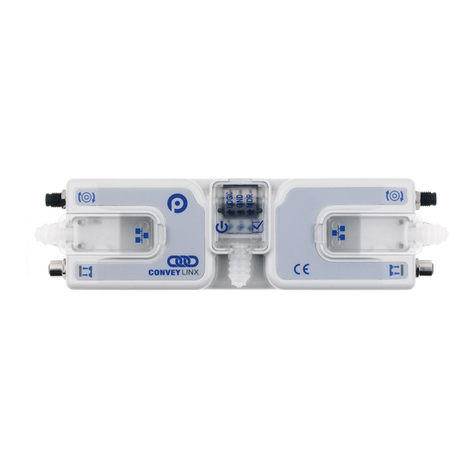
Pulseroller
Pulseroller ConveyLinx-Ai2 Connecting

Honggi
Honggi HK-A326 user manual
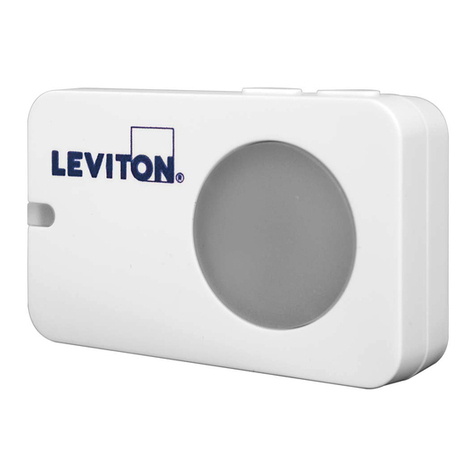
Leviton
Leviton Lumina LURPC-01W quick start guide

TIANJIN BAILI ERTONG MACHINERY
TIANJIN BAILI ERTONG MACHINERY XZA Series Operation manual
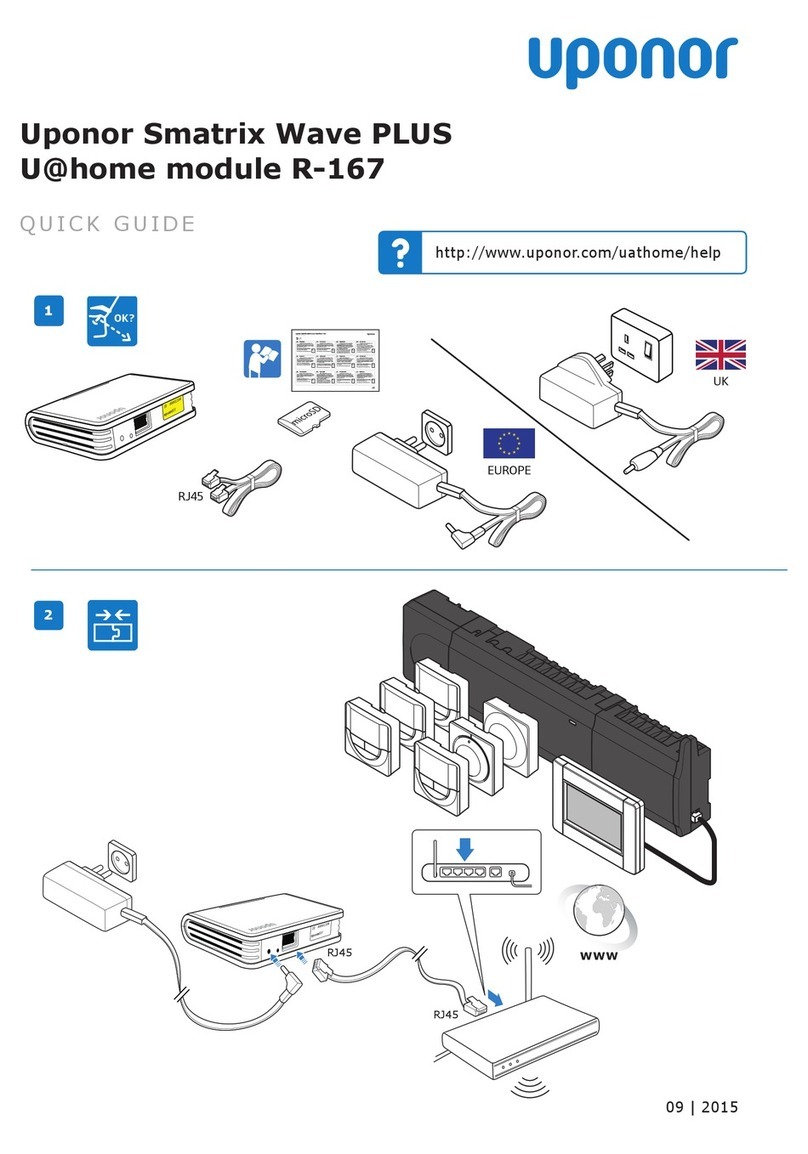
Uponor
Uponor Smatrix Wave PLUS quick guide
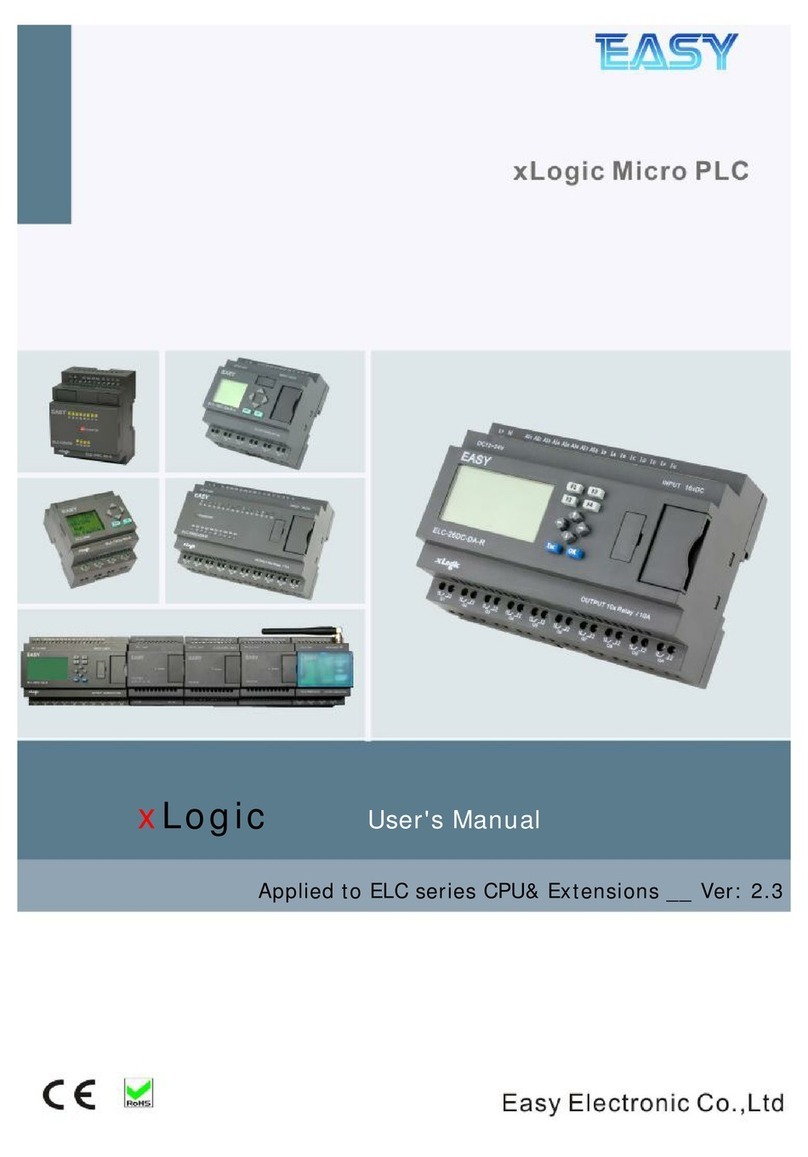
Easy Electronics
Easy Electronics xLogic Micro PLC user manual
